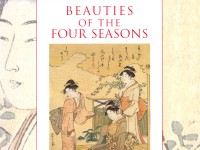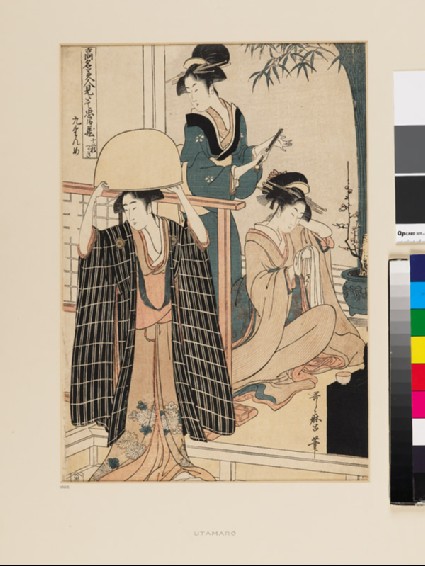Beauties of the Four Seasons
A full catalogue of the Ashmolean’s collection of Japanese bijinga (beautiful women) prints by Mitsuko Watanabe (published Oxford, 2005).

Publications online: 54 objects
Act Nine
-
Literature notes
This print is a mitate from Chūshingura ('The Storehouse of Loyal Retainers’), an epic story of a samurai vendetta based on an historical event. Led by the senior retainer Oishi Kuranosuke (1659-1703), the group of 47 men carefully bode their time, allaying enemy suspicions with frivolous behaviour, eventually avenging their lord by slaying the Daimyō Kira Yoshinaka (1641-1702) in Edo on the 14th December 1703. This became the subject of countless bunraku (puppet) and kabuki plays, and was frequently illustrated by ukiyo-e artists.
Kōmyō Bijin Mitate Chūshingura consists of celebrated beauties in twelve scenes from Chūshingura. This print shows the moment when a senior retainer, Kakogawa Honzō disguised as a komusō (a strolling priest) with a straw hat, arrives home to find his wife and daughter about to commit ritual suicide because he has determined to do so. This refers to act 9 of Chūshingura. This series was issued during the same period and by the same publisher, Konoeya, as Gonin-bijin Aikyō-kisoi (Competition of Five Lovely Women) [see EAX.4721]. Interestingly, the same women seem to appear in both series; on the left Itsutomi of the Tomimoto as a komusō, Hiranoya of the Yatsuyama in the centre and Kisegawa of the Matsuba-ya on the right. There is a plum bonsai in a ceramic flowerpot probably implying ume-mi-zuki (plum viewing in February). -
Details
- Series
- The Storehouse of Loyal Retainers Drama Parodied by Famous Beauties
- Associated place
- Date
- c. 1797 - 1798
- Artist/maker
-
Kitagawa Utamaro (c. 1753 - 1806) (designer)
- Associated people
-
Omiya Gonkurō (active c. 1794 - c. 1812) (publisher)probably Matsubaya Kisegawa II (active late 18th century) (subject)probably Tomimoto Itsutomi (probably active late 18th century) (subject)probably Yatsuyama Hiranoya (probably active late 18th century) (subject)
- Material and technique
- nishiki-e (multi-block) woodblock print, printed with water-based vegetable pigments
- Dimensions
-
mount 55.5 x 40.5 cm (height x width)
print 36.5 x 25.4 cm sight size (height x width)
- Material index
- Technique index
- Object type index
- No. of items
- 1
- Credit line
- Presented by Mrs Allan and Mr and Mrs H. N. Spalding, 1952.
- Accession no.
- EAX.4119
-
Further reading
Oxford: Ashmolean Museum, 24 August-30 November 2005, Beauties of the Four Seasons, Mitsuko Watanabe, ed. (Oxford: Ashmolean Museum, 2005), no. 15 on p. 30, illus. p. 31
Glossary (4)
mitate, mitate-e, nishiki-e, vegetable pigments
-
mitate
Mitate, or riddle, is a form of visual and literary parody on a classical theme. It required prior knowledge in order to decipher it.
-
mitate-e
Mitate-e, or riddle, is a form of visual and literary parody on a classical theme. It required prior knowledge in order to decipher it.
-
nishiki-e
Nishiki-e literally means 'brocade pictures' and refers to multi-coloured woodblock prints.
-
vegetable pigments
Vegetable pigments were used to create coloured dyes for Japanese prints, paintings, and textiles. These pigments often faded over time due to the chemical reactions they underwent.
Location
-
- currently in research collection
Objects are sometimes moved to a different location. Our object location data is usually updated on a monthly basis. Contact the Jameel Study Centre if you are planning to visit the museum to see a particular object on display, or would like to arrange an appointment to see an object in our reserve collections.
Publications online
-

Beauties of the Four Seasons
This print is a mitate from Chūshingura ('The Storehouse of Loyal Retainers’), an epic story of a samurai vendetta based on an historical event. Led by the senior retainer Oishi Kuranosuke (1659-1703), the group of 47 men carefully bode their time, allaying enemy suspicions with frivolous behaviour, eventually avenging their lord by slaying the Daimyō Kira Yoshinaka (1641-1702) in Edo on the 14th December 1703. This became the subject of countless bunraku (puppet) and kabuki plays, and was frequently illustrated by ukiyo-e artists.
Kōmyō Bijin Mitate Chūshingura consists of celebrated beauties in twelve scenes from Chūshingura. This print shows the moment when a senior retainer, Kakogawa Honzō disguised as a komusō (a strolling priest) with a straw hat, arrives home to find his wife and daughter about to commit ritual suicide because he has determined to do so. This refers to act 9 of Chūshingura. This series was issued during the same period and by the same publisher, Konoeya, as Gonin-bijin Aikyō-kisoi (Competition of Five Lovely Women) [see EAX.4721]. Interestingly, the same women seem to appear in both series; on the left Itsutomi of the Tomimoto as a komusō, Hiranoya of the Yatsuyama in the centre and Kisegawa of the Matsuba-ya on the right. There is a plum bonsai in a ceramic flowerpot probably implying ume-mi-zuki (plum viewing in February).
Notice
Object information may not accurately reflect the actual contents of the original publication, since our online objects contain current information held in our collections database. Click on 'buy this publication' to purchase printed versions of our online publications, where available, or contact the Jameel Study Centre to arrange access to books on our collections that are now out of print.
© 2013 University of Oxford - Ashmolean Museum

